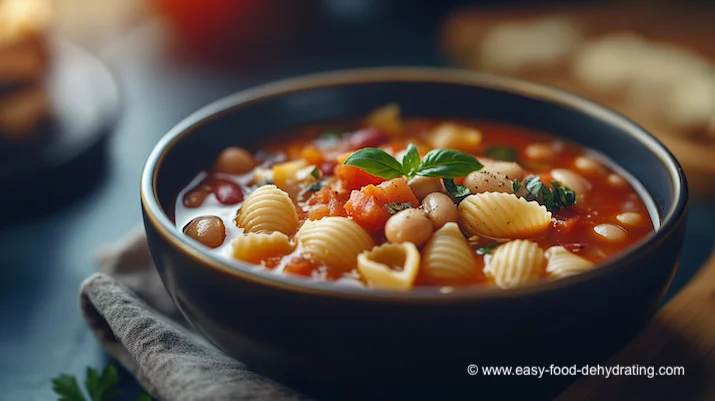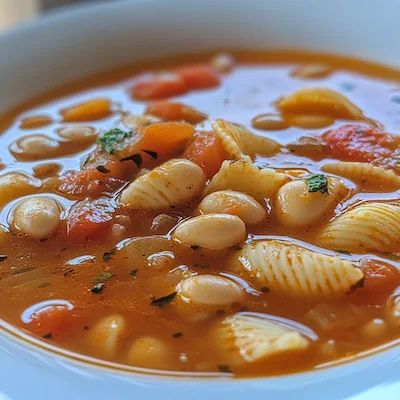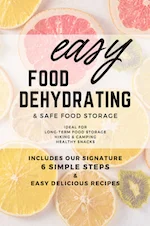- Home
- Easy Dehydrated Food Recipes
- Dehydrated Tomato Minestrone Soup Recipe
Dehydrated Tomato Minestrone Soup:
Store Now, Enjoy Later!

Susan Gast | Author and blogger at Bored Boomers, Beesville Books, A New Sober You and Easy Food Dehydrating
I love a good bowl of soup and this dehydrated tomato minestrone soup is the ultimate comfort food—rich, flavorful, and perfect for stocking up in your pantry or taking on a camping trip.

It’s a time-saver too! Instead of chopping fresh veggies every time, just rehydrate and enjoy. Plus, I always use canned beans for convenience—no overnight soaking or hours of cooking needed. (Been there, done that, don’t want to do it again!)
And if you’ve got dehydrated diced hash-brown potatoes sitting around, toss those in too! They add a little extra heartiness without any extra effort.
Why You'll Love This Soup
- Easy to Make – Just rehydrate, simmer, and enjoy.
- Packed with Flavor – Tomatoes, hearty beans, and Italian herbs make it delicious.
- Perfect for Camping – Lightweight, shelf-stable, and a breeze to prepare.
- Great for Meal Prep – Make a big batch and store it for later.
How to Dehydrate the Ingredients
Before making the soup, let’s get those veggies dehydrated. Here’s how:
🥄 Tomatoes – 135°F for 8-12 hours (Slice ¼ inch thick, done when leathery)
🥄 Carrots – 135°F for 6-8 hours (Slice ⅛ inch thick or grate, done when brittle)
🥄 Celery – 135°F for 4-6 hours (Slice ¼ inch thick, done when brittle)
🥄 Onions – 135°F for 4-8 hours (Slice ⅛ inch thick, done when crispy)
Dryness Check: Veggies should be brittle, tomatoes leathery but not sticky, and no moisture should be visible when snapped.
💡 Short on time? Store-bought dehydrated veggies work too—but homemade tastes better!
Assembling & Storing Your Dry Soup Mix
Once your veggies are dehydrated, it’s time to put everything together for easy storage and quick meal prep.
- Mix all dry ingredients in a large bowl.
- Store in an airtight container or vacuum-sealed bag for freshness.
- For camping, pack canned or pre-cooked beans separately.
🚀 Tip: Canned beans save time! If using dried beans, pre-cook them at home to avoid a long cook time at camp.
Best Storage Tips:
- Vacuum-seal in single-serving bags for grab-and-cook portions.
- Label bags with the date & contents—future you will thank you!
- Keep in a cool, dark pantry to extend shelf life (up to 6 months, or 1 year with oxygen absorbers).
💡 Need a fast meal? Pre-portion your mix so all you need to do is add water and cook—no measuring, no fuss!
How to Cook Dehydrated Tomato Minestrone Soup
🔥 At Home or Camp:
- Combine 1 cup of dry soup mix with 2 cups of water (adjust for serving size).
- Let sit for 5 minutes so ingredients can start rehydrating.
- Bring to a boil, then simmer for 10-15 minutes, stirring occasionally.
- Cool slightly, then taste—add salt, pepper, or spices if needed.
🌄 Altitude Adjustments:
- 5,000-8,000 ft: Add 1-2 minutes cooking time
- 8,000-10,000 ft: Add 3-4 minutes
- Above 10,000 ft: Add 5-6 minutes
💡 Water Ratios: For a family-size batch (4 cups of dry mix), use 7 cups of water—not quite double, as ingredients absorb liquid differently.
Flavor & Ingredient Variations

🔥 Want extra protein? Toss in some dehydrated chicken or tofu.
🌶️ Like spice? Add red pepper flakes or a dash of cayenne.
🥖 Serving suggestion? Crusty bread is perfect for dipping.
Spice It Up!
Italian Style: Basil, oregano, red pepper flakes, rosemary
Mediterranean Style: Thyme, mint, saffron
Easy Ingredient Swaps for Customizing Your Soup
Need a gluten-free option? Swap out the pasta for rice or quinoa.
Looking for extra protein? Add freeze-dried chicken or cooked lentils.
Love a smoky flavor? A pinch of smoked paprika or fire-roasted tomatoes can take this soup to the next level.

Tomato Minestrone Soup Recipe

Ingredients
- 2 cups dehydrated tomatoes (for the tomato-y texture) OR 2 cans diced tomatoes
- 1 cup dehydrated mixed vegetables (carrots, celery, onions)
- 1/2 cup canned red kidney beans or cannellini beans (white kidney beans)
- 2 cups vegetable stock
- 1/4 cup dry (uncooked) small pasta (such as small shells, ditalini, or small elbow macaroni)
- 2 tbsp tomato powder (creates the rich base of the soup)
- 1 tsp dried basil
- 1 tsp dried oregano
- 1/2 tsp garlic powder
- Salt and pepper to taste
When Using Fresh Ingredients...
Substitute dried ingredients above for when you have fresh ingredients on hand:
- 1 medium carrot
- 1 stalk celery
- 1/4 large onion
Also, feel free to substitute tomato paste for the tomato powder.
Also I love to use Better Than Bouillon vegetable stock as the base.
Instructions
- Pour dehydrated ingredients into a pot.
- Add vegetable stock: 2 cups per 1 cup of mix.
- Boil, then reduce heat and simmer for about 10-15 minutes.
- Let sit a few minutes before serving—it gets thicker as it cools.
And I wish I would stop humming to myself 10cc's "Life is a Minestrone" song...
Nutrition Information
The Nutrition Facts below are for fresh ingredients and 1 cup of veggie stock.
- Servings: 4 servings
- Calories: 166kcals
- Fat: 0.7g
- Protein: 6.6g
- Carbohydrates: 33.7g

Seasonal Vegetable Options:
Spring/Summer:
- Dehydrated zucchini
- Bell peppers
- Green beans
Fall/Winter:
- Dehydrated butternut squash
- Kale
- Parsnips
Spice Variations:
Italian Style:
- Add 1 tsp Italian seasoning
- 1/4 tsp red pepper flakes
- 1 tsp dried rosemary
Mediterranean Style:
- Add 1 tsp dried thyme
- 1/2 tsp dried mint
- Pinch of saffron
Final Thoughts…
Aside from looking amazing (rich tomato red with those hearty beans), the aroma is incredible. It’s warming, satisfying, and pure comfort food—whether you’re at home or watching the stars by the campfire.
This dehydrated tomato minestrone soup isn’t just delicious, it’s practical. Meal prep it, take it camping, or store it for a rainy day.
Get Your Free Guide to Dehydrating Like a Pro!
Don't forget to grab your free Six Simple Steps eBook! It’s packed with tips for dehydrating everything from fruits and veggies to dog treats. Get it here.
Before You Go...
If you like the content, please give me some love by clicking on the 🩷 in the lower right hand corner (on just about all my pages). This signals to me that you find it enjoyable and useful. Thank you so much!
















